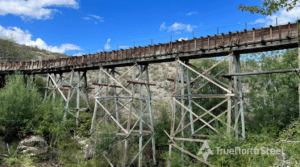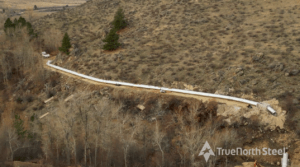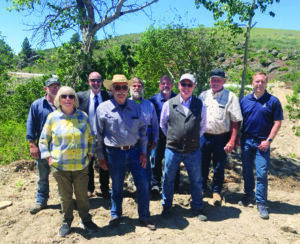
by Sarah Glass
Daly Ditches Irrigation District (DDID), responsible for delivering water services to nearly 2,100 members across 14,841 acres in the Bitterroot Valley, celebrated the removal and replacement of century-old irrigation infrastructure last Wednesday, June 12th. With project partner representatives of TrueNorth Steel out of Missoula and Glacier Precast Concrete out of Kalispell, DDID personnel introduced local media to the result of years of planning and over six months of construction work: in the place of a rotting 100-year-old flume, now a modernized 1,500-foot water siphon.

Located south of Hamilton, visitors observed Skalkaho Highline Ditch water pass through 30,000 pounds of precast concrete structures into corrosion-resistant aluminized Type II steel piping of massive diameter. Flanked by trees and large boulders, the piping route descended into a small canyon before emerging on the opposite side to drape an entire hillside with its length. Tim Meuchel, DDID manager, explained that the siphon uses gravity to deliver water to the valley below; in this way, DDID systems are interconnected, and replacing outdated infrastructure along its waterways will play a crucial role in the company’s ability to deliver needed irrigation water into the foreseeable future.
The original idea to update ditch infrastructure was to build a modular steel bridge across the canyon. This proved not to be a cost-efficient idea. Remarkably, careful revisions and resource management brought the final price of the project far under the original estimate. DDID cut the $1.2- to $1.4 million estimated price tag down to just over $600,000, thanks to a strategy of using rented equipment and in-house labor.
The entirety of the project was paid for by DDID members, too, Meuchel reported. About 12 years ago, a $3-per-acre charge was added to member service fees, and this money was designated to a catastrophe fund, he said. The fund made the siphon and paying off other of DDID’s financial obligations possible.
Giving a nod to the legacy DDID inherited along with the waterways in their care, Meuchel shared some historical facts about the development of irrigation systems in the Bitterroot Valley as well. When the Ireland-born Copper King, Marcus Daly, came to the valley in the late 1800s, he was “looking for timber and firewood and food for the miners.” To get more bench water on the property he owned, said Meuchel, Daly purchased water rights for the Hedge and Republican ditches, water assets maintained by DDID that continue to serve the needs of residents from Hamilton to Corvallis today. Daly then “started building up the ward,” and “[The Skalkaho Highline Ditch] is actually a ditch that he built and engineered the whole way,” said the DDID manager.
The now removed and replaced Skalkaho Highline Ditch flume was also a remnant of that early industrialization period in the Bitterroot Valley. Although DDID has removed 14 out of 15 of the time-worn flumes in its district, Meuchel admitted the siphon project presented new engineering challenges to the staff. Erik Powell, owner of Glacier Precast Concrete, and Paul LaMarche, TrueNorth Steel’s territory sales manager, joined Meuchel during the June 12th media event to detail the process and joke about the headaches they delegated to one another over the years.

“This project was a little bit out of our scope,” said LaMarche, “but Tim approached me; he said ‘I just want to handle the construction of the project, you deal with everything else.’ That’s when we started looking for an engineering firm, and we discovered we were going to need some pre-cast inlets and outlets. We reached out to Glacier Precast. We also contracted with an NGO technical engineer to get a survey done on the site. The engineer laid everything out on plans. Then we also generated shop drawings for our structures, including the precast structures, which allowed Tim to get started on the construction of the project.”
LaMarche then presented Meuchel with a plaque showing the siphon had been named a “2024 Project of the Year” winner by the National Corrugated Steel Pipe Association, a recognition bestowed on 13 infrastructure projects across the nation.
“One thing I was telling these guys,” Meuchel laughed, gesturing towards LaMarche and Powell, “is now that we know how to do it, we should do the next [flume] and be done.” This type of project should go a lot faster the second time around, he said.